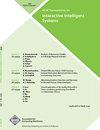RadarSense: Accurate Recognition of Mid-air Hand Gestures with Radar Sensing and Few Training Examples
IF 4.8
4区 计算机科学
Q2 COMPUTER SCIENCE, ARTIFICIAL INTELLIGENCE
引用次数: 3
Abstract
Microwave radars bring many benefits to mid-air gesture sensing due to their large field of view and independence from environmental conditions, such as ambient light and occlusion. However, radar signals are highly dimensional and usually require complex deep learning approaches. To understand this landscape, we report results from a systematic literature review of (N=118) scientific papers on radar sensing, unveiling a large variety of radar technology of different operating frequencies and bandwidths and antenna configurations but also various gesture recognition techniques. Although highly accurate, these techniques require a large amount of training data that depend on the type of radar. Therefore, the training results cannot be easily transferred to other radars. To address this aspect, we introduce a new gesture recognition pipeline that implements advanced full-wave electromagnetic modeling and inversion to retrieve physical characteristics of gestures that are radar independent, i.e., independent of the source, antennas, and radar-hand interactions. Inversion of radar signals further reduces the size of the dataset by several orders of magnitude, while preserving the essential information. This approach is compatible with conventional gesture recognizers, such as those based on template matching, which only need a few training examples to deliver high recognition accuracy rates. To evaluate our gesture recognition pipeline, we conducted user-dependent and user-independent evaluations on a dataset of 16 gesture types collected with the Walabot, a low-cost off-the-shelf array radar. We contrast these results with those obtained for the same gesture types collected with an ultra-wideband radar made of a vector network analyzer with a single horn antenna and with a computer vision sensor, respectively. Based on our findings, we suggest some design implications to support future development in radar-based gesture recognition.RadarSense:基于雷达传感的空中手势的准确识别和少量训练实例
微波雷达由于其大视场和不受环境条件(如环境光和遮挡)的影响,为空中手势传感带来了许多好处。然而,雷达信号是高度多维的,通常需要复杂的深度学习方法。为了了解这一情况,我们报告了对(N=118)篇雷达传感科学论文的系统文献综述的结果,揭示了各种不同工作频率、带宽和天线配置的雷达技术,以及各种手势识别技术。虽然准确度很高,但这些技术需要大量的训练数据,这取决于雷达的类型。因此,训练结果不容易转移到其他雷达。为了解决这方面的问题,我们引入了一种新的手势识别管道,该管道实现了先进的全波电磁建模和反演,以检索与雷达无关的手势的物理特征,即与源、天线和雷达手交互无关。雷达信号的反演在保留基本信息的前提下,将数据集的大小进一步降低了几个数量级。该方法与传统的基于模板匹配的手势识别器兼容,只需少量的训练样例即可提供较高的识别准确率。为了评估我们的手势识别管道,我们对使用低成本的现成阵列雷达Walabot收集的16种手势类型的数据集进行了用户依赖和用户独立的评估。我们将这些结果与由带有单喇叭天线的矢量网络分析仪和计算机视觉传感器组成的超宽带雷达收集的相同手势类型的结果进行了对比。基于我们的研究结果,我们提出了一些设计建议,以支持基于雷达的手势识别的未来发展。
本文章由计算机程序翻译,如有差异,请以英文原文为准。
求助全文
约1分钟内获得全文
求助全文
来源期刊

ACM Transactions on Interactive Intelligent Systems
Computer Science-Human-Computer Interaction
CiteScore
7.80
自引率
2.90%
发文量
38
期刊介绍:
The ACM Transactions on Interactive Intelligent Systems (TiiS) publishes papers on research concerning the design, realization, or evaluation of interactive systems that incorporate some form of machine intelligence. TIIS articles come from a wide range of research areas and communities. An article can take any of several complementary views of interactive intelligent systems, focusing on:
the intelligent technology,
the interaction of users with the system, or
both aspects at once.
 求助内容:
求助内容: 应助结果提醒方式:
应助结果提醒方式:


